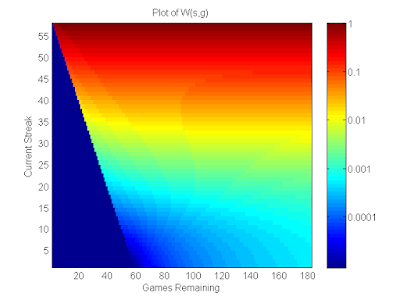Simplifying the Expected Value Formula
Probability theory is by far my favorite field in mathematics. I am particularly interested in expected value problems over a discretized domain. I often find myself thinking up and solving expected value problems that may or may not have any actual relevance.
After working on an expected value problem that I had thought up, I derived a very interesting and useful identity for computing the answer to expected value problems more easily in certain situations. My derivation is easiest to understand when the sample space is the set of natural numbers (i.e., $1, 2, 3, \dots$).
In situations when the sample space of a random variable is the set of natural numbers, the expected value is defined by this formula:
$$ \mathbf{E}(X) = \sum_{k=1}^{\infty} k \cdot P(X = k) = P(X = 1) + 2 \cdot P(X = 2) + 3 \cdot P(X = 3) + \dots $$
In some cases, this summation may be difficult to evaluate directly. However, if you represent the sum in a special way, a simple but powerful simplification can be made. Let's break down the formula by creating a grid so that the $ k^{th} $ column of the grid represents the $ k^{th} $ term in the sum in expanded form:
$$ \begin{align*}
P(X = 1) + P(X = 2) + P(X = 3) + P(X = 4) + \dots &= P(X \geq 1)\\
P(X = 2) + P(X = 3) + P(X = 4) + \dots &= P(X \geq 2)\\
P(X = 3) + P(X = 4) + \dots &= P(X \geq 3)\\
P(X = 4) + \dots &= P(X \geq 4)\\
\end{align*}$$
As you can probably see, the formula can be simplified to the following expression:
$$ \mathbf{E}(X) = \sum_{k=1}^{\infty} P(X \geq k) $$
This formula is applicable in any situation, but it is especially useful when it is somewhat messy to evaluate $P(X=k)$, but simple to express $P(X \geq k)$. It can also be useful because we don't have worry about multiplying by $k$ in the summation, since each term is added exactly once.
After working on an expected value problem that I had thought up, I derived a very interesting and useful identity for computing the answer to expected value problems more easily in certain situations. My derivation is easiest to understand when the sample space is the set of natural numbers (i.e., $1, 2, 3, \dots$).
In situations when the sample space of a random variable is the set of natural numbers, the expected value is defined by this formula:
$$ \mathbf{E}(X) = \sum_{k=1}^{\infty} k \cdot P(X = k) = P(X = 1) + 2 \cdot P(X = 2) + 3 \cdot P(X = 3) + \dots $$
In some cases, this summation may be difficult to evaluate directly. However, if you represent the sum in a special way, a simple but powerful simplification can be made. Let's break down the formula by creating a grid so that the $ k^{th} $ column of the grid represents the $ k^{th} $ term in the sum in expanded form:
$$ \begin{align*}
P(X = 1) + P(X = 2) + P(X = 3) + P(X = 4) + \dots &= P(X \geq 1)\\
P(X = 2) + P(X = 3) + P(X = 4) + \dots &= P(X \geq 2)\\
P(X = 3) + P(X = 4) + \dots &= P(X \geq 3)\\
P(X = 4) + \dots &= P(X \geq 4)\\
\end{align*}$$
As you can probably see, the formula can be simplified to the following expression:
$$ \mathbf{E}(X) = \sum_{k=1}^{\infty} P(X \geq k) $$
This formula is applicable in any situation, but it is especially useful when it is somewhat messy to evaluate $P(X=k)$, but simple to express $P(X \geq k)$. It can also be useful because we don't have worry about multiplying by $k$ in the summation, since each term is added exactly once.

Comments
Post a Comment